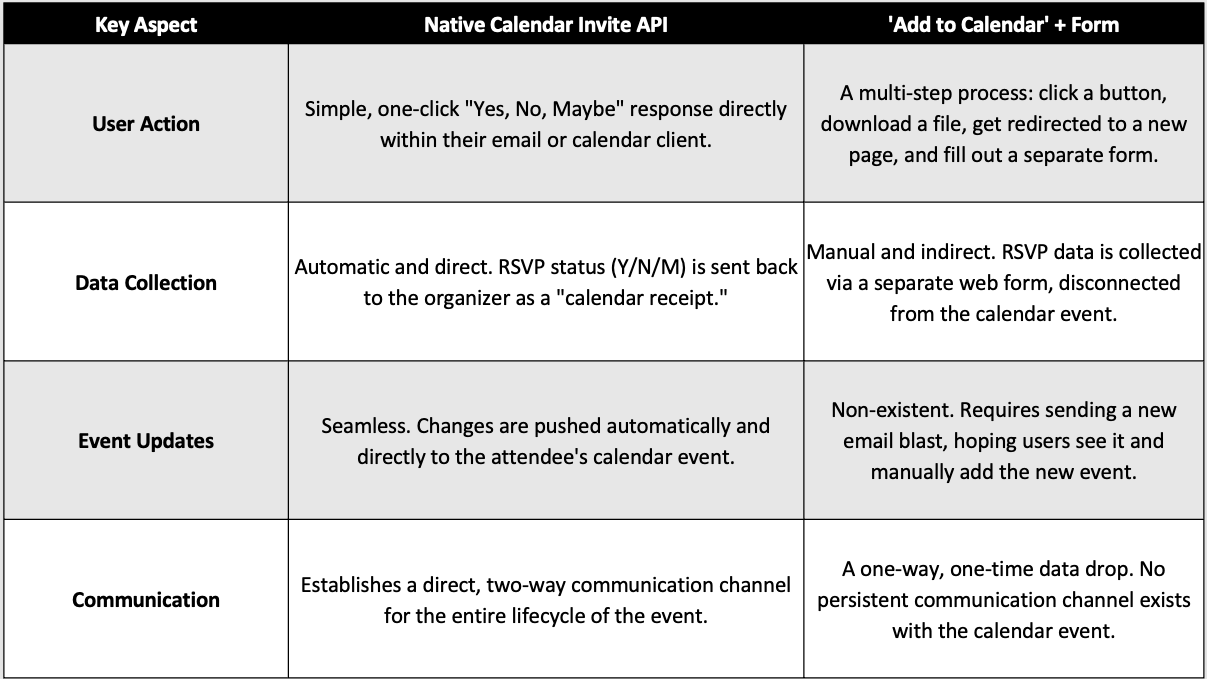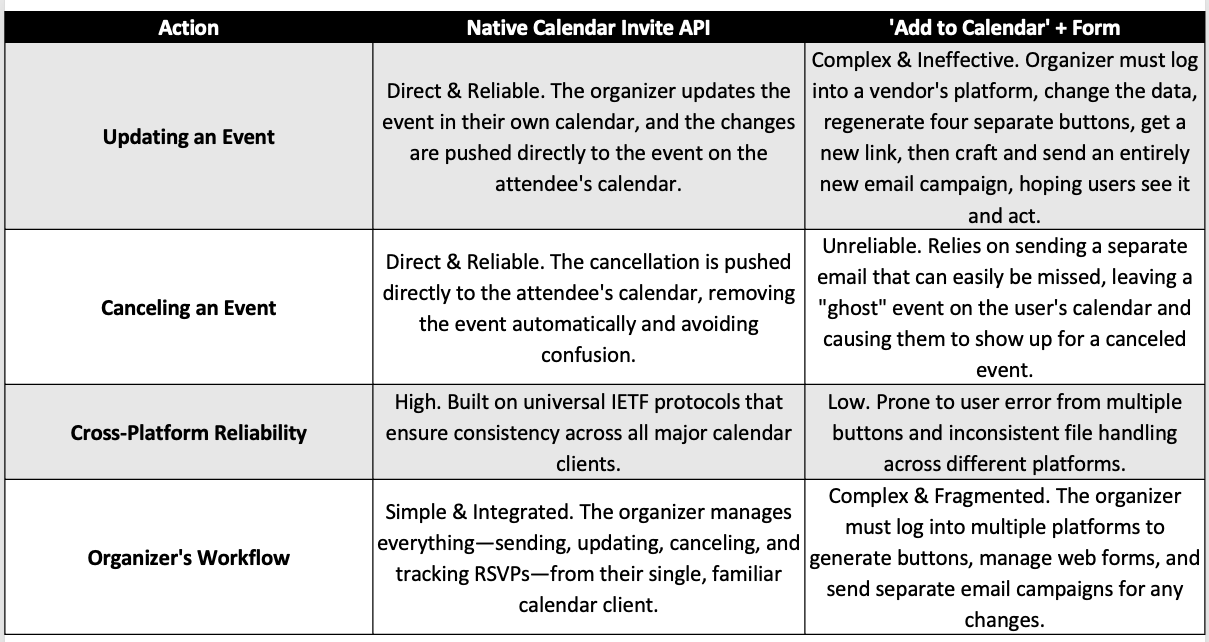Native Calendar Invite vs Add to Calendar Buttons + RSVP Forms
Talk directly to your customers calendar
Native Calendar Invite vs Add to Calendar Button + Forms: A Clear Comparison
1. Introduction: Two Ways to Schedule, Two Very Different Experiences
When you want to get an event onto someone’s calendar, you have two primary digital tools at your disposal: sending a Native Calendar Invite or providing an ‘Add to Calendar’ button. While both aim for the same outcome, they operate in fundamentally different ways, leading to vastly different experiences for both the attendee and the event organizer.
Think of it this way: a native invite is like a direct, two-way conversation with your attendee’s calendar. You send an invitation, they respond, and you can both update each other if things change. In contrast, an ‘Add to Calendar’ button is like handing someone a static, printed flyer. They can put it on their fridge (their calendar), but the flyer can’t tell you if they’re coming, nor can it update itself if the event details change.
This document will break down the key differences between these two methods to help you, as an aspiring marketer or developer, understand why this distinction is critical for creating seamless experiences and gathering reliable data.
Let’s begin with a high-level overview of how these two approaches stack up.
2. At a Glance: The Core Differences
This table synthesizes the fundamental distinctions between a native calendar invite sent via an API and the combination of an ‘Add to Calendar’ button with a separate RSVP form.
Now that we have a bird’s-eye view, let’s dive deeper into what these differences mean for the person you’re trying to invite: the attendee.
3. The Attendee Journey: A Tale of Two Workflows
The user experience is paramount, and the workflow for each method reveals a stark contrast between simplicity and complexity.
The Native Invite: A Low-Friction Interaction
With a native calendar invite, the process is seamless and integrated directly into the tools the attendee already uses. The entire interaction takes place in one location with a single action.
1. The user receives an invitation directly in their email inbox.
2. They click one of the native buttons—“Yes, No, or Maybe”—to instantly RSVP and add the event to their calendar.
This low-friction journey is intuitive, fast, and respects the user’s time.
The ‘Add to Calendar’ Button: A High-Friction Process
This method forces the user into a disjointed process of downloading a static file while simultaneously being redirected to a separate page to fill out a form. This fragmented and confusing workflow increases the chance they will abandon it entirely.
1. The user is presented with multiple buttons (e.g., Google, Apple, Outlook) and must first select the correct calendar provider.
2. This click triggers a file download (.ics) that they must then open and save to their calendar manually.
3. Simultaneously, they are redirected to a new page where they must fill out a separate ‘bolt-on’ form to RSVP—a step completely disconnected from the event file they may or may not have successfully added to their calendar.
This high-friction process creates a disjointed and cumbersome attendee experience. For organizers, the native invite is the clear winner for ensuring a positive and effective interaction.
From the user’s perspective, we now move to what the organizer sees: the data and communication channel that is created.
4. Data & Communication: The Power of a Direct Connection
A key advantage of the native calendar invite is its ability to establish a direct connection with the attendee’s calendar, enabling automatic and reliable data collection. This is achieved through what are known as “calendar receipts.”When an attendee clicks “Yes,” “No,” or “Maybe,” their calendar client automatically sends that response back to the event organizer’s server.
This method of data collection has three key advantages:
• Automatic: No manual forms are needed. The RSVP is captured as part of the native calendar interaction.
• Direct: A two-way channel is established for the lifecycle of the event, allowing for future updates and communication.
• Real-time: The organizer receives immediate updates if an attendee changes their status later (e.g., from ‘Maybe’ to ‘Yes’ or from ‘Yes’ to ‘No’).
In stark contrast, the ‘Add to Calendar’ button, combined with a form, is a ‘one-way, one-time data drop.’ The RSVP data collected from the web form is wholly disconnected from the static event file the user downloaded. This means the organizer knows someone filled out a form, but has no idea if the event is actually on that person’s calendar. The two pieces of information exist in separate universes.
Furthermore, if an attendee needs to change their RSVP, they cannot do it from their calendar. They would have to locate the original RSVP form and log in to update their status, a process that is unlikely and unintuitive.
This difference in data flow has massive implications for how you manage your event after the initial invitation is sent.
5. Event Management: Reliability vs. Chaos
Managing event changes is where the superiority of the native invite becomes undeniable. A native invite creates a living connection to the event on an attendee’s calendar, whereas an ‘Add to Calendar’ button creates a dead-end. This is where the analogy becomes reality: you cannot ask a printed flyer to change its date, but you can easily update a partner in a conversation.
This table compares how each method handles critical event management tasks.
As you can see, what starts as a simple choice of technology has profound effects on operational efficiency and reliability. This leads us to our conclusion.
6. Conclusion: Choosing the Right Tool for the Job
While both technologies aim to schedule an event, they are not interchangeable. The choice between them reflects a fundamental difference in strategy.
The Native Calendar Invite API creates a dynamic, reliable, and direct two-way communication channel to the attendee’s calendar. It provides a superior, low-friction user experience, delivers automatic and actionable RSVP data, and allows for seamless event management from a single interface.
The ‘Add to Calendar’ button is a fundamentally broken workaround that shifts the burden of event management onto the user. It creates a poor experience, leaves the organizer with fragmented and unreliable data, and descends into chaos the moment an event detail needs to change.
For any marketer focused on creating seamless attendee experiences, ensuring reliable event management, and capturing actionable data, the native calendar invite is the decisively superior technology. It is the professional tool for a professional job.
Please take a look at the NFL Demo Site to see the embedded calendar invites at work for the NFL Schedule.



